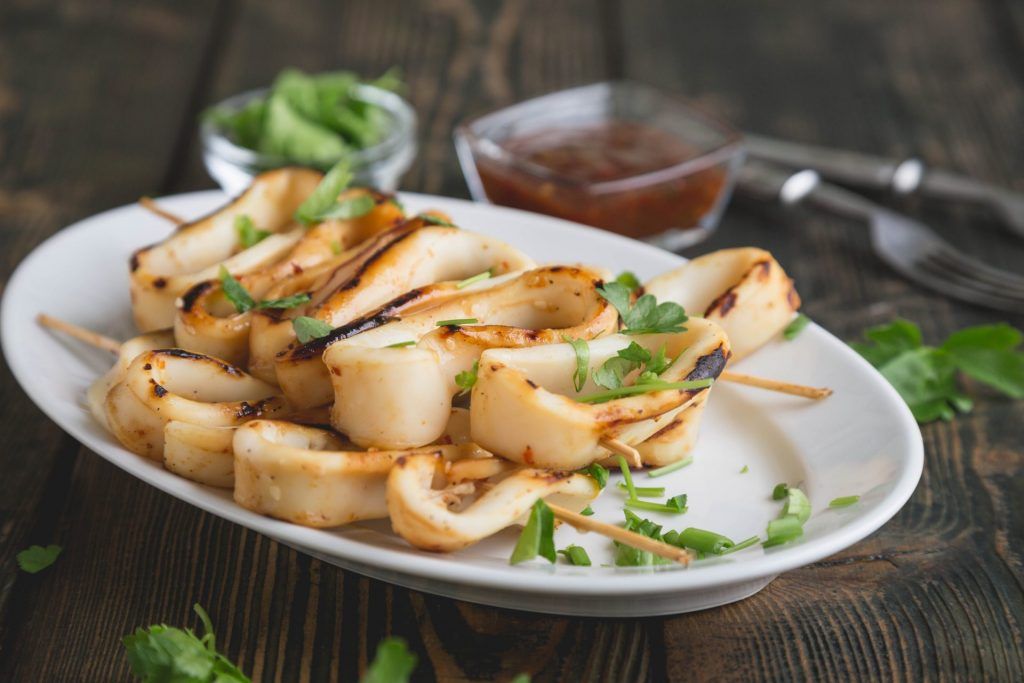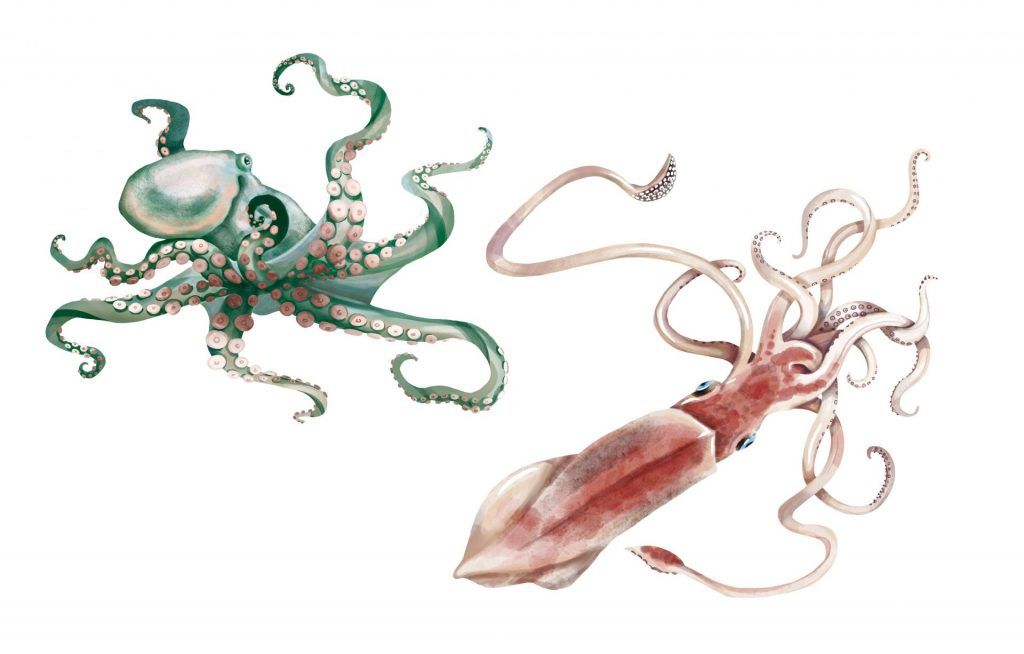Squid, or calamari, has a love-hate fanbase. Either you love its unique taste or despise the sight of it. Not much of a middle ground on this one. Regardless of your feelings, though, your dog is probably begging for it, even from across the room.
You may have thought about letting them try this tasty treat, but…
Can dogs eat squid and calamari? Is it safe and healthy for them?
In this article, we will explore the benefits and risks of feeding squid and calamari to dogs, as well as how to prepare them properly. By the end of this article, you will have a better understanding of whether dogs can eat squid and calamari and how to feed them to your furry friend.
What is Squid and What is Calamari?
Squid and Calamari are the same thing. Calamari is an Italian word meaning “squid” and is often used in the culinary world to refer to squid meat. Similar to how we call a ribeye steak beef instead of cow. In some regions, calamari specifically refers to a type of squid called the Loligo, which has a long, slender body. As a general rule, however, the two names are used interchangeably.
Squids are cephalopods, which are marine animals with tentacles and a head. They are related to octopus, cuttlefish, and nautilus. Squid is the common name for any member of the order Teuthida, which includes more than 300 species of various sizes and shapes. Some squid species are as small as 3/4 of an inch up to a massive 59 feet long for the longest measured giant squid.
Squid are edible and have a mild flavor and a chewy texture. They are usually cooked by frying, grilling, baking, or boiling and served as appetizers, main courses, or snacks. Squid are high in protein, low in fat, and rich in minerals such as iron, zinc, selenium, and iodine. They also contain omega-3 fatty acids, which are beneficial for the heart, brain, skin, and coat.

Photo Credit: Shutterstock
Can Dogs Eat Squid?
The answer is yes; dogs can safely eat cooked squid in moderation. Squid is not toxic or harmful to dogs as long as it is cooked properly and fed in small amounts. Squid is also an excellent source of protein for dogs, especially for those who need a low-fat diet or have allergies to other animal proteins. It provides essential fatty acids as well that can improve the dog’s immune system, reduce inflammation, and promote healthy skin and coat.
However, there are some risks associated with feeding squid to dogs. Here are some to keep in mind:
Parasites or Bacteria
Raw squid can contain bacteria or parasites that can cause digestive problems or infections in dogs. That’s why properly cooking any squid before offering it to your dog is important.
Choking
Squid has a rubbery texture that can sometimes be difficult for dogs to chew. If you have a larger squid, cut it into small pieces or strips before letting your dog eat it if you are concerned.
Seafood Allergies
Seafood allergies are rare in dogs, but they do still occur. If you notice any signs of your dog having a seafood allergy after eating squid, like itching, hives, swelling, vomiting, or difficulty breathing, stop feeding it immediately and consult your veterinarian.
Squid Ink
While not exactly a risk per se, some folks may be concerned about squid ink staining their dog. It is possible that squid ink will stain your dog’s teeth, mouth, or fur, but it is harmless.
Squid ink actually has a number of health benefits like fighting off stomach ulcers, reducing blood pressure, and anti-microbial properties. Evidence also suggests that squid ink contains anti-cancer properties that reduce tumor size and prevent cancerous cells from spreading.
But if the ink concerns you when feeding your dog, you can get pre-cleaned squid (without the ink sac) from most grocery stores that carry squid.
Mercury
Squid, like any other seafood, contains mercury, which in large amounts can be harmful or fatal. Fortunately, squid contains lower levels of mercury compared to other marine animals, making it a much safer option where mercury is concerned. According to the FDA, squid is classified as a “Best Choice” for seafood due to its low mercury levels.
A dog suffering from mercury poisoning due to eating squid is rare as long as they aren’t allowed to gorge themselves on it daily.
How Much Squid Can Dogs Eat?
When feeding your dog squid, it should not make up more than 10% of their daily intake. Too much squid, like any food not specifically made for dogs, can upset their stomach or cause a nutrient imbalance.
It’s best to limit the frequency of feeding your dog squid to once or twice a week as a treat or supplement.
A few other points to keep in mind is how it is prepared.
Squid, or calamari, is often fried or coated with batter or breadcrumbs, which is not recommended for dogs. Fried foods can lead to obesity, pancreatitis, and other health problems in dogs. The batter or breadcrumbs also usually have ingredients that are toxic to dogs or contain common allergens, like wheat, corn, salt, garlic, onion, xylitol, and other spices.
Grilling, baking, or boiling squid is typically the safest option when feeding it to dogs. You should still avoid any sauces or seasonings that contain ingredients not suitable for dogs.
How to Feed Squid and Calamari to Your Dog?
If you decide to feed squid or calamari to your dog, you should follow these steps:
- Choose fresh or frozen squid that is suitable for human consumption. Avoid canned or processed products that may contain preservatives, additives, or salt.
- Cook thoroughly until it is opaque and firm. Do not feed raw squid or calamari to your dog.
- Cut the squid into small pieces or strips that are easy for your dog to chew and swallow. Remove the beak, eyes, and pen (hard internal shell structure) if they are still present.
- Do not fry or coat with batter or breadcrumbs. Instead, grill, bake, or boil with minimal oil and seasonings.
- Do not feed more than 10% of your dog’s daily calories from squid or calamari.
- Monitor your dog’s reaction. If your dog shows signs of digestive upset, allergic reaction, choking, intestinal blockage, mercury poisoning, or seafood intolerance, stop feeding it immediately and consult your veterinarian.
Examples of How to Prepare Squid for Dogs
- Boil some water in a pot and add a pinch of salt. Add the squid to the boiling water and cook for about 15 minutes until tender. Drain the water and let it cool slightly. Cut the squid or calamari into small pieces and serve to your dog.
- Preheat the oven to 450°F. Cut the squid or calamari into rings and toss them with some olive oil (small amount). Spread the rings evenly on the baking sheet and bake for about 15 minutes until golden and crisp. Let them cool slightly and serve to your dog.
- Heat a grill pan over medium-high heat and brush it with some olive oil. Cut the squid or calamari into strips and grill them for about 10 minutes per side until charred and cooked through. Let them cool slightly and serve to your dog.
Healthy Alternatives or Additions for Dogs
- Vegetables: You can add steamed or boiled vegetables to your dog’s squid or calamari dish, such as carrots, broccoli, green beans, or peas. These can provide some vitamins, minerals, and fiber for your dog. However, you should avoid vegetables that are toxic or harmful to dogs, such as onions, garlic, mushrooms, or tomatoes.
- Rice: You can mix some cooked rice with your dog’s squid or calamari dish as long as it is plain and unsalted. Rice can be a good source of carbohydrates and energy for your dog. It can also help soothe your dog’s stomach if they have diarrhea or vomiting.
- Eggs: You can add some scrambled or boiled eggs to your dog’s squid or calamari dish as long as they are plain and cooked thoroughly. Eggs can be a great source of protein and amino acids for your dog. They can also help improve your dog’s skin and coat condition.
Squid vs. Octopus for Dogs

Photo Credit: Shutterstock
You may be wondering if there is any difference between squid and octopus for dogs. Although they are both cephalopods, octopus has fewer tentacles and a larger head than squid. Octopus is also tougher and chewier than squid, which can make it harder for dogs to eat. Additionally, octopus may have more mercury than squid, which can pose a health risk for dogs if consumed in large amounts or frequently.
Fun Fact: Octopuses don’t actually have tentacles. They have 8 arms, along with 3 hearts and 9 brains.
If you want to feed your dog some cooked, un-seasoned octopus, it is safe for them to eat. Just follow the same steps and precautions as feeding squid to your dog.
Health Benefits of Squid
Squid is a nutritious food that is safe for dogs to eat. It can:
- Reduce Blood Pressure
- Reduce Stomach Ulcers
- Prevent or Fight Cancer
- Provide Omega 3 Fatty Acids
- Provide B6 and B12 Vitamins
- Provide Additional Protein
- Promote Coat Color and Health
It’s not a good idea to replace your dog’s diet of normal dog food. But adding squid in small amounts can be great for dogs’ health.
























